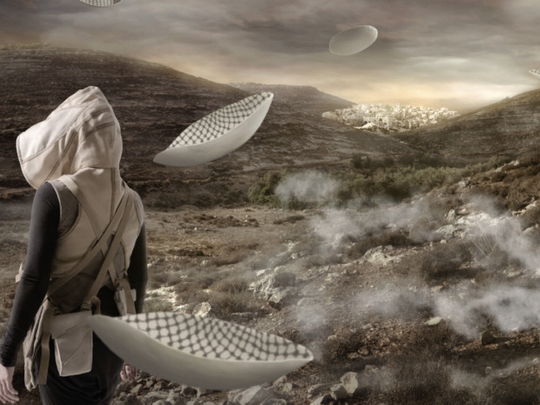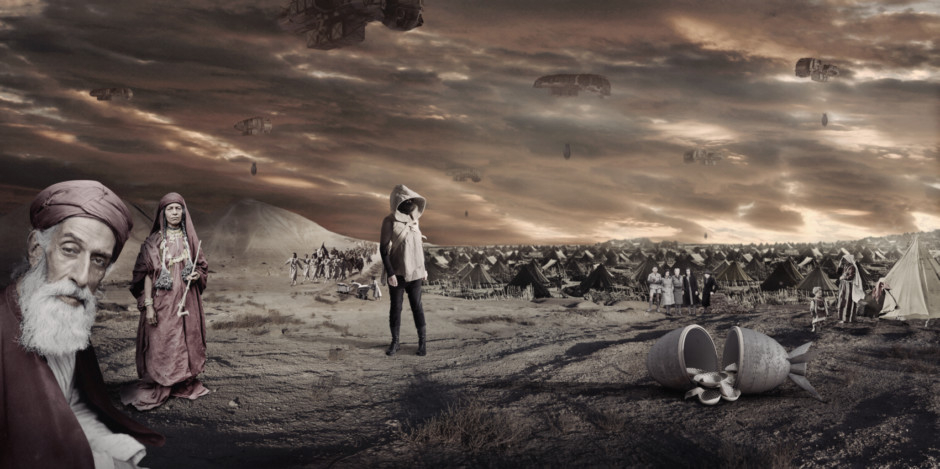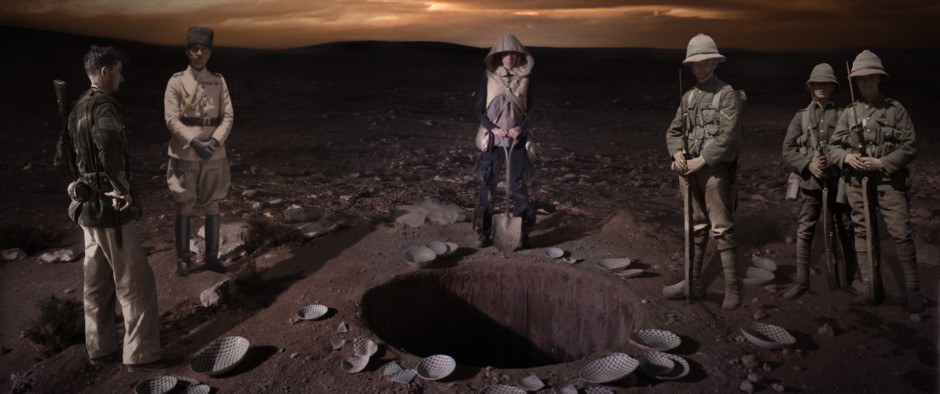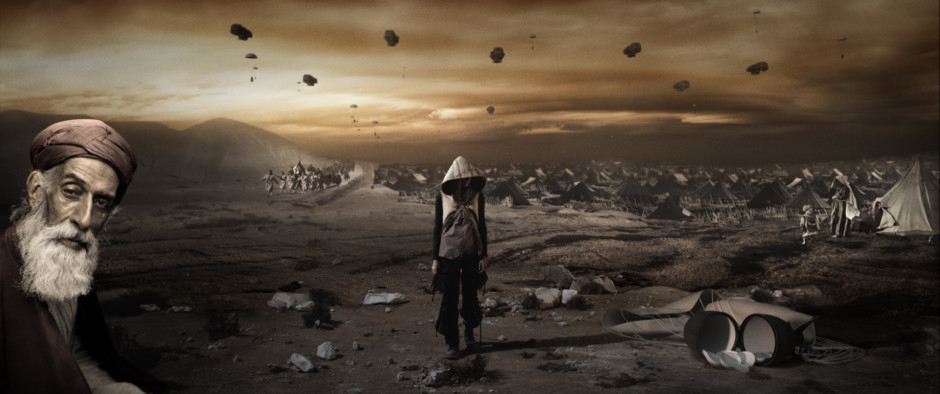
Larissa Sansour imagines fantastical solutions to political problems
Larissa Sansour feels that the world has become immune to the stereotypical images of Palestine. Hence, the Occupied Jerusalem-born artist, who now lives between Copenhagen and London, has decided to try a different approach to draw attention to the loss of Palestinian land, culture and identity and the injustice and indignity of living under occupation. She uses science fiction and her imagination to seek fantastical solutions for resolving these political problems.
In her first sci-fi film “Space Exodus” Sansour appeared as a Palestinian astronaut who triumphantly plants her nation’s flag on the Moon. In her next project “Nation Estate” she proposed a Palestinian state in the form of a skyscraper, with various Palestinian cities on each floor. Here she appeared as a futuristic traveller, who could zoom into the State on an express train, and travel from one city to another by elevator without having to pass through any Israeli checkpoints.
In her latest film “In the Future They Ate from The Finest Porcelain” Sansour takes the story further by conjuring a sci-fi scenario that paves the way for a future generation of Palestinians to claim their right to their land. The film is accompanied by three large scale photographic works and an installation that together make a strong, witty and cynical statement about the way history can be fabricated to falsify truths and justify injustice.
Through these works, the artist examines the politics of archaeology, and how myths of the past can become historic interventions with the power to create nationhood. Although neither Palestine nor Israel is ever mentioned, the project subtly alludes to Israeli tactics of strengthening their connection to Occupied Jerusalem through the contrived findings of archeological digs.
The film combines sci-fi and archival imagery and is set in an ambiguous time and place. Just like the play of tenses in its title, the film, moves back and forth between the past, present and future, and between the inner and outer worlds of the protagonist to create a manufactured history.
Sansour appears in this film only as the narrator’s voice. The female protagonist in the film describes herself as a “narrative terrorist”, and is being questioned by an unknown person, who could be a journalist, a psychiatrist or an interrogator. She reveals that she belongs to a resistance group whose weapons are porcelain plates, decorated with the typical Palestinian kefiyyeh motif, which is a symbol of Palestinian resistance.
Their plan is to airdrop the plates — packed inside bomb-like containers, into the future Palestine State, and bury them deep in the ground. The protagonist claims to have found a way to fake the age of the porcelain so that when these artefacts of a fictional civilisation are excavated by archaeologists in the future, and studied by carbon dating, they will help to support the claims of a future generation to that land.
Sansour spoke to Weekend Review about various elements and details of this carefully constructed work. Excerpts:
The keffiyeh porcelain first appeared in “Nation Estate”. How does this film take the story forward?
My first film shows that it is easier for a Palestinian to reach the Moon than to get to Occupied Jerusalem. The second looks deeper into what is happening on the ground as Israeli colonies keep encroaching on Palestinian land, leaving us no option but to have a vertical future state. I used many symbols in the film, including the porcelain with the keffiyeh pattern to say that when you are a culture in limbo rather than an organic living one, and you start clinging to such symbolic elements, they actually become empty and meaningless.
This film completes the trilogy of sci-fi films by bridging the gap between fiction and reality and bringing the fictional porcelain into Palestinian land. Here, the keffiyeh porcelain functions as the DNA of Palestinians. This film looks at how resistance movements are embedded in psychological trauma. The protagonist’s little sister was killed, and her crazy thoughts and actions originate from that trauma. This is the story of Palestine, which has lost something and is trying to retrieve it.
What is the significance of mythology and archaeology in this story?
The references to mythology and archaeology comment on how Israel was formed and how it has systematically expunged the idea of Palestinian presence. Nowhere in the world can religion and myth take precedence over legal claim, but Israel can cite mythology to confiscate without compensation the ancestral properties of families such as mine in Occupied Jerusalem.
Archaeology is always in the headlines in Israel because they use it as a means to somehow prove their myths as historic reality. The rebel’s elaborate plan to save her people by burying the porcelain in the ground for future archaeologists exposes the revisionist nature of the way history is told, and how mythology can be used to deny heritage and legality. However, this is a universal situation, because history is written by the victors.
What is the concept behind the mix of images and the mesmerising music in the film?
For the musical score, I worked with an Iraqi musician from Istanbul to remake well-known Palestinian resistance songs from Ottoman times. The imagery spans different eras from Ottoman and British times to the present. It includes footage shot in Palestine, staged studio images and archival images of Palestinian cities, people in traditional Palestinian attire, children in Palestinian state school uniforms, the exodus during the Nakba and a juxtaposition of traditional Bedouin tents with the tents in refugee camps.
I have used biblical references and images of people from different religious groups in Palestine because religion plays an important role in the political dynamic of the area. The porcelain dishes falling from the sky and the locust-like spacecraft reference apocalyptic scenes in the Bible, and feed into the apocalyptic nature of the film. I believe that apocalypse is an important theme in sci-fi films because they want us to think about preventing apocalyptic scenarios from happening in the future, by changing our actions today.
Why are the costumes different from the futuristic ones in the earlier films?
These are traditional folkloric costumes from Bethlehem, and they are an important part of the narrative. Everyone knows about Bethlehem — the place where I grew up, but most people think it is a mythological place. For centuries, pilgrims from around the globe have been coming to Bethlehem, taking back garments and fabrics with typical Palestinian embroidery, which actually inspired the early European depictions of Christ’s clothing. But despite all this real history, the existence of Palestinians in that area is still questioned today.
The protagonist and her dead sister are also seen in this traditional dress, which becomes a symbol of national identity. So, the protagonist on her deathbed alludes to a dying nation; but with the hope of a resurrection in the future. I also specifically used the Palestinian dialect of Arabic in the dialogues.
How are the photographic works different from the film?
They tell the entire story in a condensed form. Here, you can see all of the recent colonisers of Palestine, from the Ottomans to the British and Israelis, witnessing the burial of the porcelain plates because they were instrumental in burying the 5000-year-old Palestinian culture and then denying its existence. The lone protagonist from the film is seen as part of a group here, which lends some credence to her crazy claims.
What is the installation about?
It is called “Revisionist Production Line”, and depicts an apparently abandoned assembly line used for the production of the fictional porcelain plates. The deliberately crude work highlights how our past can be systematically controlled and fabricated for mass consumption like a product.
Jyoti Kalsi is an arts-enthusiast based in Dubai.
“In the Future They Ate from The Finest Porcelain” will run at Lawrie Shabibi gallery, Al Quoz, until March 3.














